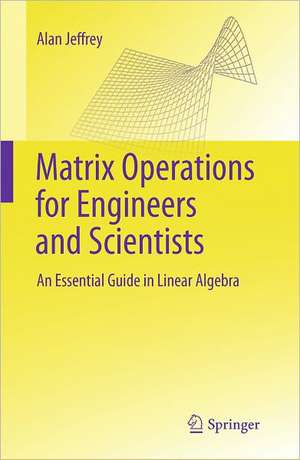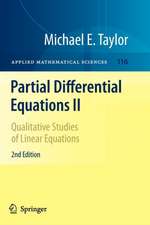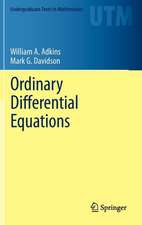Matrix Operations for Engineers and Scientists: An Essential Guide in Linear Algebra
Autor Alan Jeffreyen Limba Engleză Paperback – 14 sep 2010
Preț: 389.88 lei
Nou
Puncte Express: 585
Preț estimativ în valută:
74.63€ • 81.09$ • 62.73£
74.63€ • 81.09$ • 62.73£
Carte tipărită la comandă
Livrare economică 21 aprilie-05 mai
Preluare comenzi: 021 569.72.76
Specificații
ISBN-13: 9789048192731
ISBN-10: 9048192730
Pagini: 282
Ilustrații: IV, 278 p.
Dimensiuni: 155 x 235 x 17 mm
Greutate: 0.46 kg
Ediția:2010
Editura: SPRINGER NETHERLANDS
Colecția Springer
Locul publicării:Dordrecht, Netherlands
ISBN-10: 9048192730
Pagini: 282
Ilustrații: IV, 278 p.
Dimensiuni: 155 x 235 x 17 mm
Greutate: 0.46 kg
Ediția:2010
Editura: SPRINGER NETHERLANDS
Colecția Springer
Locul publicării:Dordrecht, Netherlands
Public țintă
Upper undergraduateCuprins
1. MATRICES AND LINEAR SYSTEMS.- 1.1 Systems of Algebraic Equations.- 1.2 Suffix and Matrix Notation.- 1.3 Equality, Addition and Scaling of Matrices.- 1.4 Some Special Matrices and the Transpose Operation. Exercises.- 1 2. DETERMINANTS AND LINEAR SYSTEMS.- 2.1 Introduction to Determinants and Systems of Equation.- 2.2 A First Look at Linear Dependence and Independence.- 2.3 Properties of Determinants and the Laplace Expansion Theorem.- 2.4 Gaussian Elimination and Determinants.- 2.5 Homogeneous Systems and a Test for Linear Independence.- 2.6 Determinants and Eigenvalues. Exercises.- 2 3. MATRIX MULTIPLICATION, THE INVERSE MATRIX AND THE NORM.- 3.1 The Inner Product, Orthogonality and the Norm 3.2 Matrix Multiplication.- 3.3 Quadratic Forms.- 3.4 The Inverse Matrix.- 3.5 Orthogonal Matrices 3.6 Matrix Proof of Cramer’s Rule.- 3.7 Partitioning of Matrices. Exercises 34. SYSTEMS OF LINEAR ALGEBRAIC EQUATIONS .- 4.1 The Augmented Matrix and Elementary Row Operations.- 4.2 The Echelon and Reduced Echelon Forms of a Matrix.- 4.3 The Row Rank of a Matrix 4.4 Elementary Row Operations and the Inverse Matrix.- 4.5 LU Factorization of a Matrix and its Use When Solving Linear Systems of Algebraic Equations.- 4.6 Eigenvalues and Eigenvectors. Exercises.- 4 5. EIGENVALUES, EIGENVECTORS, DIAGONALIZATION, SIMILARITY AND JORDAN FORMS.- 5.1 Finding Eigenvectors.- 5.2 Diagonalization of Matrices.- 5.3 Quadratic Forms and Diagonalization.- 5.4 The Characteristic Polynomial and the Cayley-Hamilton Theorem.- 5.5 Similar Matrices 5.6 Jordan Normal Forms.- 5.7 Hermitian Matrices. Exercises.-56. SYSTEMS OF LINEAR DIFFERENTIAL EQUATIONS.- 6.1 Differentiation and Integration of Matrices.- 6.2 Systems of Homogeneous Constant Coefficient Differential Equations.- 6.3 An Application of Diagonalization 6.4 The Nonhomogeneeous Case.- 6.5 Matrix Methods and the Laplace Transform.- 6.6 The Matrix Exponential and Differential Equations. Exercises.- 6.7. AN INTRODUCTION TO VECTOR SPACES.-7.1 A Generalization of Vectors.- 7.2 Vector Spaces and a Basis for a Vector Space.- 7.3 Changing Basis Vectors.- 7.4 Row and Column Rank .- .5 The Inner Product.- 7.6 The Angle Between Vectors and Orthogonal Projections.- 7.7 Gram-Schmidt Orthogonalization.- 7.8 Projections.- 7.9 Some Comments on Infinite Dimensional Vector Spaces. Exercises 78. LINEAR TRANSFORMATIONS AND THE GEOMETRY OF THE PLANE.- 8.1 Rotation of Coordinate Axes.- 8.2 The Linearity of the Projection Operation.- 8.3 Linear Transformations 8.4 Linear Transformations and the Geometry of the Plane. Exercises.- 8Solutions to all Exercises.
Recenzii
From the reviews:
“This work addresses all of the standard fare associated with an introductory course in linear algebra, albeit with an applied perspective appropriate for the audience suggested by its title. … Readers wishing to apply the methods of linear algebra to engineering problems would certainly find this book appropriate. … Summing Up: Recommended. Academic libraries serving upper-division undergraduates through researchers/faculty.” (D. S. Larson, Choice, Vol. 48 (7), March, 2011)
“This book meets the needs of engineers and scientists for an introduction to linear algebra in a context they understand. It provides a very detailed treatment of the theory of matrices … . There are numerous worked examples throughout the book and sets of exercises are provided at the end of each chapter, with all the solutions given at the end of the book. A special effort is made to keep all numerical calculations simple.” (Rabe von Randow, Zentralblatt MATH, Vol. 1210, 2011)
“This work addresses all of the standard fare associated with an introductory course in linear algebra, albeit with an applied perspective appropriate for the audience suggested by its title. … Readers wishing to apply the methods of linear algebra to engineering problems would certainly find this book appropriate. … Summing Up: Recommended. Academic libraries serving upper-division undergraduates through researchers/faculty.” (D. S. Larson, Choice, Vol. 48 (7), March, 2011)
“This book meets the needs of engineers and scientists for an introduction to linear algebra in a context they understand. It provides a very detailed treatment of the theory of matrices … . There are numerous worked examples throughout the book and sets of exercises are provided at the end of each chapter, with all the solutions given at the end of the book. A special effort is made to keep all numerical calculations simple.” (Rabe von Randow, Zentralblatt MATH, Vol. 1210, 2011)
Notă biografică
Alan Jeffrey is emeritus professor of engineering mathematics at Newcastle. He has had a distinguished career which included work at University of Delaware, Stanford, Wisconsin and City University Hong Kong. He has published 14 books, some at undergraduate level and others at the research monograph level, some with Springer, and his sales records look very good. He also is well known because he edited some important reference works such as the Handbook of Mathematical Formula.
Textul de pe ultima copertă
Engineers and scientists need to have an introduction to the basics of linear algebra in a context they understand. Computer algebra systems make the manipulation of matrices and the determination of their properties a simple matter, and in practical applications such software is often essential. However, using this tool when learning about matrices, without first gaining a proper understanding of the underlying theory, limits the ability to use matrices and to apply them to new problems. This book explains matrices in the detail required by engineering or science students, and it discusses linear systems of ordinary differential equations. These students require a straightforward introduction to linear algebra illustrated by applications to which they can relate. It caters of the needs of undergraduate engineers in all disciplines, and provides considerable detail where it is likely to be helpful.According to the author the best way to understand the theory of matrices is by working simple exercises designed to emphasize the theory, that at the same time avoid distractions caused by unnecessary numerical calculations. Hence, examples and exercises in this book have been constructed in such a way that wherever calculations are necessary they are straightforward. For example, when a characteristic equation occurs, its roots (the eigenvalues of a matrix) can be found by inspection.The author of this book is Alan Jeffrey, Emeritus Professor of mathematics at the Univesity of Newcastle upon Tyne. He has given courses on engineering mathematics in UK and US Universities.
Caracteristici
Carefully explains each operation with matrices and offers many worked examples to show how to use these operations Provides exercises with each chapter - solutions at the end of the book Explains how matrices can be used for solving homogeneous and non-homogeneous differential equations Introduces linear algebra in a context that engineers and science students can understand Supplies the foundation required to intelligently use and interpret results of computer-algebra packages Includes supplementary material: sn.pub/extras













